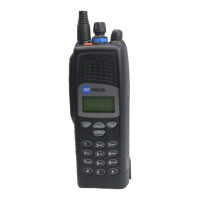60 Circuit Descriptions TP9100 Service Manual
© Tait Electronics Limited May 2005
3.4 Frequency Control Loop
Introduction The FCL is included in the block diagram of the frequency synthesizer
(see Figure 3.4).
The FCL forms part of the frequency-synthesizer circuitry. The basis of the
FCL is a VCXO, which generates the reference frequency required by the
main PLL of the synthesizer.
Elements of
FCL Circuitry
The FCL is a simple frequency-locked loop. The circuitry consists of the
following elements:
■ VCXO (XL501, Q501, Q503)
■ TCXO (XL500)
■ buffer amplifier (IC500)
■ mixer (IC501)
■ low-pass filter (IC502, pins 5 to 7)
■ modulator buffer amplifier (IC502, pins 1 to 3)
The TCXO supplies a reference frequency of 13.0000MHz, which is
extremely stable, regardless of the temperature. The VCXO runs at a
nominal frequency of 13.0000MHz, and is frequency-locked to the TCXO
reference frequency.
Circuit Operation The VCXO output is mixed with the TCXO output to create a nominal
difference (or offset) frequency
SYN CDC FCL of 12.0 kHz. The signal SYN CDC
FCL is fed via the CODEC IC502 in the CODEC circuitry to the FPGA.
The FPGA detects the offset frequency, compares it with the programmed
offset frequency, and outputs a corresponding feedback signal
CDC VCXO MOD
via IC205. The feedback signal is amplified and inverted by the modulator
buffer amplifier and output as the loop voltage for the VCXO. With this
design the VCXO frequency can be adjusted by very small precise amounts,
and because the loop is locked, the VCXO inherits the temperature stability
of the TCXO.
Modulation The FCL modulation is implemented within the FPGA and appears at the
output of IC205, and therefore on the VCXO loop voltage. Consequently,
the VCXO is frequency modulated directly by the relevant modulation
information. The latter may be the microphone audio, an audio tap-in
signal, internal modem signals, or any combination of these.

